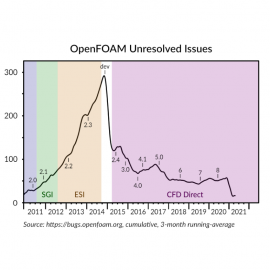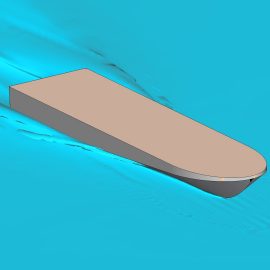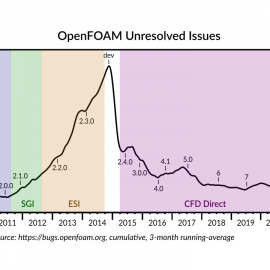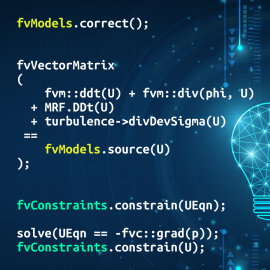In March 2021, CFD Direct replaced fvOptions with new fvModels and fvConstraints classes. fvModels provided a more complete framework for implementation of complex models which could be optionally selected during a simulation. New fvModels were implemented for heat transfer and sources, which are easier to configure than a general fvOption. Pressure limiting was implemented as an fvConstraint named limitPressure, consistent with limitVelocity and limitTemperature. With additional fvModels such as cloud and surfaceFilm, solvers such as reactingFoam replicate the functionality of several existing solvers which are deprecated.
Productive CFD with OpenFOAM

We design our OpenFOAM Training so that users can learn effective CFD, giving them the confidence to carry out CFD analysis, repeatedly, to a defined standard in a timely manner. We provide 4 courses that teach reliable procedures to configure, run and maintain CFD simulations. While creating and improving these courses, we have contributed tools to OpenFOAM for more productive CFD, so that users waste less time on routine tasks. They include the post-processing command line interface, template cases, and tools for case setup, monitoring simulations, quick documentation and code customisation.
CFD Direct Year 6: 2020-2021

In Year 6 of CFD Direct, our developments of OpenFOAM included new interface capturing methods and multicomponent transport models. We provided core maintenance, including redesign of fvOptions and transport modelling, and repaired issues, e.g. in meshing and conjugate heat transfer. We managed the OpenFOAM Foundation, releasing OpenFOAM v8, packaging OpenFOAM-dev and publishing websites and documentation. During the Covid restrictions, we delivered 67 days of Live Virtual OpenFOAM Training, and provided cloud CFD with CFDDFC® to over 700 subscribers.
Redesigning OpenFOAM for the Future

In 2020, CFD Direct were tasked to develop multicomponent diffusion modelling in OpenFOAM with funding from the Process Engineering Consortium. The Consortium need models, e.g. Maxwell-Stefan, that represent complex diffusion of species in fluid mixtures, affecting both specie concentration and energy. As part of the work, we created a new ThermophysicalTransportModels library with a new interfaces for: fluxes of heat, q() and divq(); and fluxes of mass, j() and divj(). As a consequence, heat transfer became consistent across applications, boundary conditions and data processing. This critical code redesign is typical of our strategy for sustainable development of OpenFOAM, supported by dedicated maintenance funding from OpenFOAM supporters.
Interface Capturing in OpenFOAM

In July 2020, CFD Direct released a framework for surface interpolation in interface capturing for multiphase flows in OpenFOAM. All interpolation schemes, used for flux calculation in advection, operate with the MULES-based solvers, e.g. interFoam. The framework is easy to use, extensible, and robust due to bounded, conservative numerics. The new framework comes with a new family of interpolation schemes based on piecewise-linear interface calculation (PLIC). The PLIC schemes provide a promising alternative to standard interface compression, performing better for meshes with regions of cell refinement. All schemes are conservative, bounded and robust and can run efficiently with large time steps.
CFD Direct Year 5: 2019-2020

In Year 5 of CFD Direct, we developed new functionality in OpenFOAM and maintained critical components of the code base. We managed the OpenFOAM Foundation: promoting sustainable development, releasing OpenFOAM v7, packaging OpenFOAM-dev and publishing websites and documentation. We delivered 60 days of OpenFOAM Training, and provided low-cost cloud CFD with CFD Direct From the Cloud™ to over 500 subscribers, including custom images to run 100s of automated production simulations.

